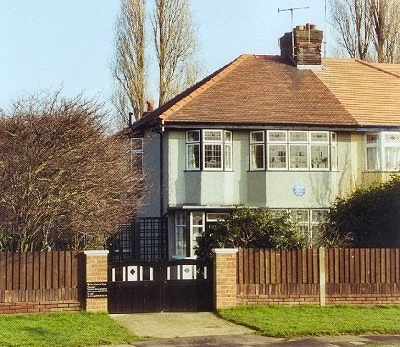| Mendips and John Lennon |
| Mendips,
251 Menlove Avenue, in Woolton was the home of
John Winston Lennon (1940-80),
musician, song-writer, composer and political
activist,
from 1945 to 1963. He was the son of Alfred Lennon (1912-76), a
merchant seaman, and Julia Stanley (1914-58).
Alfred was often away at sea, which had its
effect on the marriage, and he finally left Julia
for good in 1942. The situation for John at home
with his mother was subsequently not ideal and
there was a mutually agreed arrangement that he
live with Julia's sister, his aunt Mary Elizabeth
'Mimi' Smith (1906-91) at Mendips. |
| John was brought up
lovingly but strictly by Mimi, who attempted to
instill middle-class values into him in contrast
to the more working class background that he came
from. John remained strongly attached to his
mother, but she was tragically killed in a road
accident outside Mendips in 1958 after being hit
by a car driven by a drunken, off-duty police
officer. When at Mendips, John went to Dovedale
Primary School, where he was bright and bookish
and began to show an interest in art. He listened
to The Goon Show on the radio, which
influenced his sense of humour. In 1952 he moved
on to Quarry Bank High School (see below). The
band he formed there, The Quarrymen,
practiced at Mendips, but Mimi relegated them to
the front porch because of the noise. His
childhood experiences no doubt exerted a
particularly strong influence upon his character
as a mature artist. |
| Mendips was
bought for the National Trust by Yoko
Ono and lovingly restored to an authentic 1950s
condition, with period artefacts and Lennon
memorabilia. Anyone who lived through the 1950s
will find the time-warp eerily effective and
John's presence palpable. |
|
 |
| Mendips |
|